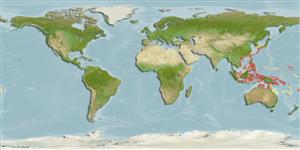>
Gobiiformes (Gobies) >
Gobiidae (Gobies) > Gobiinae
Etymology: Cryptocentrus: Greek, kryptos = hidden + Greek, kentron = sting (Ref. 45335).
Environment: milieu / climate zone / depth range / distribution range
Ecologie
marien rifbewoner; diepte 1 - 5 m (Ref. 90102). Subtropical
Western Pacific: Philippines, Taiwan, the Ryukyu Islands, and Palau.
Grootte / Gewicht / Leeftijd
Maturity: Lm ? range ? - ? cm
Max length : 7.5 cm SL mannelijk / geslacht onbekend; (Ref. 48637)
Dorsale stekels (totaal): 6 - 7; Dorsale zachte stralen (totaal): 11; Anale stekels 1; Anale zachte stralen: 10. Resembles C. leucostictus and C. maudae, but lacks dark bars dorsally.
Characterized by the following: brilliant white snout and back; brown color on most of head and body with variable-sized white spots; white spot on base of upper pectoral fin rays; basal part of lower pectoral fin with white spot or triangular marking; united pelvic fins, presence of frenum; longitudinal scale series 113-130; head without scales; greatest depth of body 5.9-6.3 in SL; rounded caudal fin, slightly longer than head (Ref. 90102).
Lives in silty sandy substrate with small boulders or large rubble pieces in few meters depth (Ref. 48637). Associated with snapping shrimp in their burrows.
Levenscyclus en paargedrag
Maturiteit | Voortplanting | Paaien | Eieren | Fecunditeit | Larven
Masuda, H., K. Amaoka, C. Araga, T. Uyeno and T. Yoshino, 1984. The fishes of the Japanese Archipelago. Vol. 1. Tokai University Press, Tokyo, Japan. 437 p. (text). (Ref. 559)
Status op de Rode Lijst van het IUCN (Ref. 130435)
Gevaar voor de mens
Harmless
Gebruik door de mens
Meer informatie
Lokale namenSynoniemenMetabolismePredatorenEcotoxicologieVoortplantingMaturiteitPaaienPaaiaggregatiesFecunditeitEierenOntwikkeling van de eieren
ReferentiesAquacultuurAquacultuurprofielKweeklijnenGeneticaElectrophoresesErfelijkheidZiektesVerwerkingNutrientsMassaconversie
Tools
Speciale rapporten
Download XML
Internetbronnen
Estimates based on models
Preferred temperature (Ref.
123201): 25.2 - 29.3, mean 28.8 °C (based on 1604 cells).
Fylogenetische diversiteitsindex (Ref.
82804): PD
50 = 0.5000 [Uniqueness, from 0.5 = low to 2.0 = high].
Bayesian length-weight: a=0.00708 (0.00333 - 0.01504), b=3.09 (2.92 - 3.26), in cm total length, based on LWR estimates for this (Sub)family-body shape (Ref.
93245).
Trofisch niveau (Ref.
69278): 3.3 ±0.4 se; based on size and trophs of closest relatives
Weerstandsvermogen (Ref.
120179): Hoog, minimale populatieverdubbelingstijd minder dan 15 maanden (Preliminary K or Fecundity.).
Fishing Vulnerability (Ref.
59153): Low vulnerability (10 of 100).
